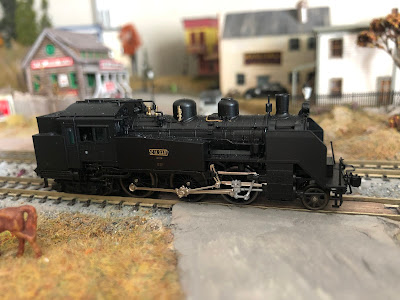The C11 steam locomotive has been part of the Kato range for a long time, the first model produced in 1971. It remained part of the Kato range for more than 40 years, incrementally improved in minor ways but notably over-scale. In 2021, Kato released a completely new model that was properly to scale and also featured a coreless motor and much more fine detailing. It appears to represent the third tranche of C11s built between 1940 and 1941, but as they ran during the 1960s -- most obviously, with the addition of the electric LP42 headlight on the front.
Background
These JNR locomotives have a two-cylinder, 2-6-4T wheel arrangement and Walschaerts valve gear. No fewer than 381 examples of the class were produced between 1932 and 1947, albeit across four different generations. They were designed for use on suburban and branch lines, but were eventually seen all over Japan. Typical jobs included local passenger trains and short distance freight trains, but they occasionally worked limited express and even sleeper trains. As time passed and passenger work was taken over by railcars of various sorts, the C11s took on more freight work and even operated as shunting locomotives. By the 1960s even this sort of work was being handled by diesel and electric locomotives and mass withdrawals began, but some remained in service until 1975. Six have been preserved in working order, and more than 50 can be found as static exhibits around the country.
Kato ED75-1000 (3075-4)
What's in the box?
- C11 locomotive with working head and tail lamps
- Metallic-effect number plates (four different locos)
- Dummy couplers
- Rapido couplers
- Kato knuckle couplers
With the exception of their recent foray into 00-9 narrow gauge models, Kato's steam locomotives are not much seen outside Japan and the US. That's a bit of shame if this model is anything to go by, because it's really nice. It runs very well, apparently down to 216-mm radius curves, and mine certainly handles 282-mm radius curves without any fuss at all. It's a decent hauler too, pulling at least four carriages without any sign of slipping.
Detailing is good. There's a mix of moulded and separately fitted details including handrails and pipes of all sorts. The cab includes glazed windows and even details on the outside that can be seen when the model is held up to the light. Headlamps are fitted to both ends of the loco, and these light up in the direction of travel.
While the model features a lot of attractive detail, this comes as a mix of plastic and brass separately fitted parts. The brass parts look excellent, but the plastic parts, like the upright poles on the front platform, are easily bent out of shape. Similarly, while having the option of different numbers makes it easy to have multiple examples of the class on your layout without duplication, the brass-effect plastic pieces are fiddly to apply and the paint seems to chip off easily. Installing them is a little bit of a faff, since you need to cut them off a sprue and then push them into a moulded recess on the model. Masking tape is one way to hold the pieces without then flying off onto the carpet, but there's a risk the tape will pull off some of the paint.
The valve gear works well, but again, the mix of metal with plastic parts isn't ideal. The colours don't quite match. From normal viewing distances the differences in colour aren't obvious, and a bit of weathering might help. But still, it's a bit annoying.
Performance is as you'd expect from any modern Kato locomotive: smooth and quiet, albeit with an unrealistically high top speed (the real locos were limited to 85 km/h). On clean track the loco will crawl along fairly well but of course the short wheelbase does make them sensitive to 'dead spots' on the track.
Conclusion
Although this is one of the smallest steam locomotives that Kato produce, at 12,100 Yen (just over £60) it still represents quite good value. The model runs as well as it looks, and even if the livery is a bit dull, the type had a very long working life and could be found doing all sorts of work almost anywhere in the country. Some remain in use even today, working special services (called SL trains) such as the SL Fuyu no Shitsugengo (Steam Locomotive Winter Wetlands) service in Hokkaido.
Incidentally, the C11 is one of the locomotives for which Kato produce a Sound Card. It's a lot of fun!





No comments:
Post a Comment